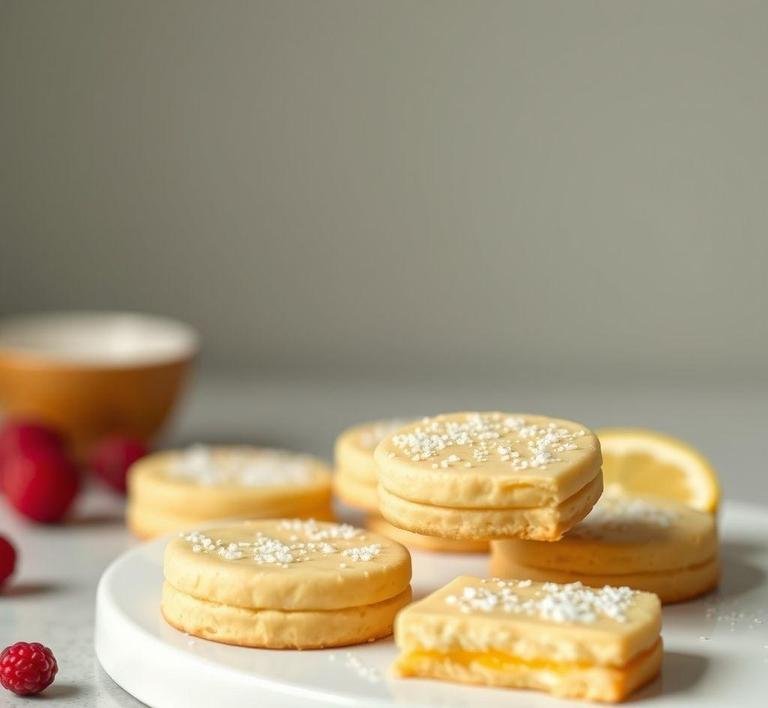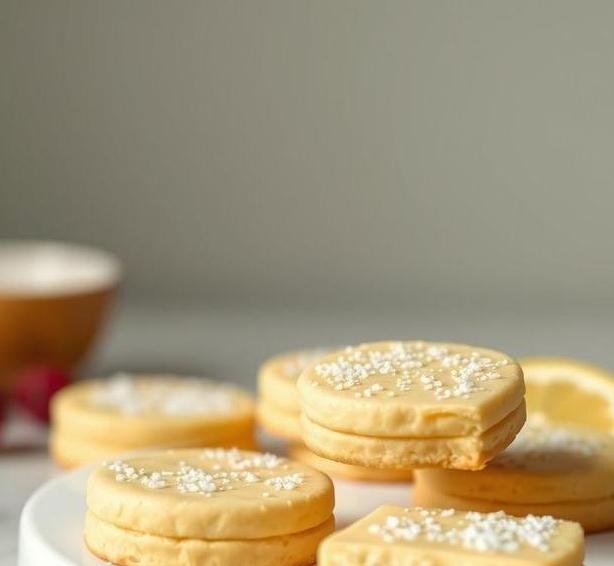Mary Berry’s Lemon Shortbread is a delightful variation of the classic shortbread biscuit, infused with the zesty freshness of lemon. As one of Britain’s most beloved bakers, Mary Berry has the unique ability to elevate simple, comforting recipes into something truly special. Her Lemon Shortbread is no exception. The texture is wonderfully crumbly and buttery, while the tangy lemon zest provides a refreshing contrast to the richness of the shortbread. This recipe marries the buttery, melt-in-the-mouth goodness of traditional shortbread with the citrusy vibrancy of lemon, making it a perfect treat for any occasion.
Whether served with a hot cup of tea or as a sweet snack after a meal, Mary Berry’s Lemon Shortbread offers the perfect balance of sweet and tangy. The citrus flavor doesn’t overpower the delicate shortbread base; instead, it complements it in such a way that each bite feels like a small celebration. It’s an easy-to-make recipe, and with a few simple ingredients, you can have a batch of these irresistible biscuits ready to enjoy in no time.
Mary Berry’s Lemon Shortbread Recipe
Ingredients Needed

To make Mary Berry’s Lemon Shortbread, you will need a handful of basic baking ingredients that come together to create the perfect texture and flavor. Here’s what you’ll need:
- 250g unsalted butter – The star of any shortbread, butter adds a rich, smooth flavor and gives the biscuits that melt-in-your-mouth texture. Using unsalted butter allows you to control the level of salt in the dough, but make sure it’s softened to room temperature for easy mixing.
- 100g caster sugar – Caster sugar, or superfine sugar, dissolves easily in the dough, ensuring that the shortbread has a smooth texture without any graininess. This also adds a subtle sweetness to balance the sharpness of the lemon.
- 300g plain flour – Plain flour (or all-purpose flour in the U.S.) is essential for giving the shortbread structure. It will create that crumbly, melt-in-the-mouth texture that makes shortbread so irresistible.
- Zest of 1 lemon – The zest is the key to adding that fresh, citrusy zing that defines Mary Berry’s version of shortbread. You want to avoid the pith, as it’s bitter, but the zest will bring a fragrant, lively flavor to the dough.
- A pinch of salt – Even though you’re using unsalted butter, a pinch of salt enhances the overall flavor and helps balance the sweetness of the shortbread.
- A small amount of lemon juice (optional) – Some recipes add a teaspoon of lemon juice to the dough for a slightly stronger lemon flavor, but this is completely optional. It adds a bit of extra zestiness if you’re looking to intensify the citrus profile.
These ingredients are simple and accessible, making this recipe perfect for both beginner bakers and seasoned professionals.
Equipment Needed
To make Mary Berry’s Lemon Shortbread, you won’t need any fancy equipment – just a few essential tools that you likely already have in your kitchen. Here’s what you’ll need:
- Mixing bowl – A large bowl to mix the butter, sugar, flour, and lemon zest. Ideally, you want a bowl with enough room for easy mixing without splattering ingredients everywhere.
- Electric mixer or wooden spoon – While you can use a hand mixer, a classic wooden spoon will also do the job of beating the butter and sugar together, which is the first step of making shortbread. If using an electric mixer, be sure to switch to a low setting to prevent the flour from flying out of the bowl.
- Rolling pin – To roll out the dough to the desired thickness before cutting it into shapes. A smooth, sturdy rolling pin will help you achieve an even thickness for your shortbread.
- Baking sheet – You’ll need a baking sheet to place the shortbread on while it bakes. Make sure it’s lined with parchment paper or a silicone baking mat to prevent the cookies from sticking and make for easy cleanup.
- Biscuit cutters (optional) – If you want to give your Lemon Shortbread a more professional appearance, you can use biscuit cutters to create uniform shapes. However, shortbread can also be simply cut into squares or rectangles using a sharp knife.
- Cooling rack – A cooling rack is essential to allow the freshly baked shortbread to cool evenly. This prevents it from becoming soggy on the bottom due to trapped steam.
These simple tools are all you need to prepare this delectable treat!
Instructions To Make Mary Berry’s Lemon Shortbread
Now, let’s dive into the step-by-step process of making this scrumptious Mary Berry Lemon Shortbread.
- Preheat the oven – Start by preheating your oven to 170°C (150°C fan-assisted), or 340°F (300°F for a fan oven). This ensures the oven is at the perfect temperature when your dough is ready.
- Prepare your baking tray – Line a baking sheet with parchment paper or a silicone baking mat. This will prevent the shortbread from sticking and make cleanup much easier.
- Mix the butter and sugar – In a large mixing bowl, beat the softened butter and caster sugar together until the mixture is pale and fluffy. This can be done with an electric hand mixer or with a wooden spoon if you prefer a bit of a workout. The goal is to incorporate air into the butter to create a light, airy texture in the shortbread.
- Add the lemon zest and flour – Once the butter and sugar are well combined, add the lemon zest. Give it a quick mix, and then gradually sift in the plain flour and a pinch of salt. Mix everything together gently until it forms a dough. Be careful not to overwork the dough as this could make the shortbread tough instead of crumbly.
- Shape the dough – Turn the dough out onto a lightly floured surface. Use your hands to knead it gently until it comes together into a smooth ball. Roll it out to about 1cm (0.5 inches) thick. If you want, you can use biscuit cutters to create fun shapes, or simply cut it into squares or rectangles for a more rustic feel.
- Bake the shortbread – Place the shaped dough onto your prepared baking sheet, spacing the pieces evenly. Bake for around 12-15 minutes, or until the shortbread is golden and firm to the touch. Keep an eye on it to ensure it doesn’t brown too much.
- Cool and serve – Once the shortbread is done, remove it from the oven and let it cool on the baking sheet for 5 minutes. Then, transfer it to a wire cooling rack to cool completely. This ensures it retains its delicate crumbly texture.
If you’d like to add a bit of extra sweetness, you can dust the shortbread with a light sprinkling of caster sugar before serving.
Tips And Tricks
- Use room temperature butter: Softened butter mixes much better with the sugar, ensuring a smoother dough and a fluffier texture.
- Don’t overwork the dough: Overworking the dough can lead to tough shortbread. Mix until just combined and handle the dough gently.
- Chill the dough: If the dough becomes too soft to work with, pop it in the fridge for 10-15 minutes to firm up before rolling it out. This will make it easier to shape.
- Try different flavors: While lemon is the star in this recipe, you can easily switch up the citrus by using orange or lime zest for a different twist.
- Perfect baking temperature: Shortbread bakes at a lower temperature than many cookies. This allows it to become crisp without burning, so always bake at the recommended temperature and avoid rushing the process.
Mary Berry’s Lemon Shortbread is a delicious fusion of rich, buttery shortbread and the fresh zing of lemon, making it a perfect treat for any occasion. With its simple ingredients and easy-to-follow instructions, this recipe allows you to create bakery-quality shortbread at home. Whether enjoyed on its own, with a cup of tea, or as a gift, it’s sure to become a favorite in your baking repertoire.
The balance of flavors – the smooth butter, the sweetness of the sugar, and the refreshing tang of lemon – makes each bite melt in your mouth. With a few easy tips to elevate your technique, you can make these biscuits even more perfect. So next time you’re craving a treat that’s both indulgent and fresh, turn to Mary Berry’s Lemon Shortbread – it’s the perfect biscuit to bake when you want to impress without the stress!
Easy Recipe Variations For Mary Berry’s Lemon Shortbread

Mary Berry’s Lemon Shortbread is a timeless, delightful treat. The buttery, melt-in-your-mouth shortbread base combined with the zesty, refreshing lemon flavor is an irresistible combination. However, if you’re in the mood to experiment or want to give it a unique twist, there are plenty of easy variations to play with. Whether you want to change the flavor profile, the texture, or even the appearance, the possibilities are endless!
1. Add A Lemony Glaze Or Icing
One way to elevate the tanginess of the lemon is by drizzling a lemon glaze over your shortbread. A simple glaze made from powdered sugar, lemon juice, and a hint of lemon zest creates a sweet, tart topping that complements the shortbread’s richness. It’s a beautiful addition that not only enhances the flavor but also gives your shortbread an elegant finish. For an extra touch, you could even sprinkle a little extra lemon zest or edible glitter for visual flair.
2. Incorporate Fresh Herbs For A Savory Twist
If you want to turn your shortbread into something more savory with a subtle herby twist, consider adding finely chopped rosemary or thyme to the dough. Rosemary and lemon are a classic pairing, bringing a refreshing yet earthy dimension to your shortbread. These additions give the biscuits a slightly more complex flavor profile that will surely surprise and delight anyone who tries them.
3. Add Almonds For Extra Texture
For a nutty twist, incorporate finely ground almonds or almond flour into the shortbread dough. Almonds not only add a slight nuttiness but also enhance the texture, creating a slightly more crumbly yet rich consistency. A combination of almond and lemon is a classic flavor duo, and the almonds can give the shortbread a delightful, slightly crunchy bite.
4. Spice It Up With Ginger
If you enjoy a little spice, adding ground ginger to the dough can complement the citrus flavor in an unexpected but delicious way. The warmth of ginger adds depth to the lightness of the lemon, creating a more complex flavor that’s both comforting and refreshing. Ginger can work in tandem with the lemon, offering a spicy-sweet note that’s perfect for the cooler months.
5. Make It A Double-Lemon Treat
If you’re a fan of bold citrus flavors, double down on the lemon! Instead of just using lemon zest and juice in the dough, try incorporating a few drops of lemon extract to really intensify the lemon flavor. The extract can bring a concentrated citrus punch that balances the sweetness of the shortbread, making it even more zesty and vibrant.
6. Experiment With Flavored Sugar
Instead of using regular granulated sugar to sprinkle on top before baking, try experimenting with flavored sugar. A lemon-sugar mix or even a lavender-sugar blend can infuse the shortbread with a unique fragrance and depth. This variation works especially well if you want a more aromatic experience with your lemon shortbread.
7. Add Dried Fruit Or Cranberries
For a bit of chewiness and color, consider adding dried fruit like cranberries, cherries, or apricots to the dough. The tartness of dried fruit can contrast wonderfully with the buttery shortbread and fresh lemon flavor. This variation also adds an attractive pop of color to your shortbread, making it perfect for festive occasions.
Storing Leftovers
There’s nothing worse than making a batch of Mary Berry’s Lemon Shortbread and having it go stale too soon. Luckily, this delightful treat is easy to store and can be kept fresh for several days or even weeks. Here’s how to store your shortbread to maintain its delicious texture and flavor:
1. Room Temperature Storage (Short-Term)
If you plan on consuming your lemon shortbread within a few days, you can store it at room temperature. Simply place the shortbread in an airtight container to prevent it from drying out. Be sure to store them in a cool, dry place away from direct sunlight and heat sources. This will help preserve the shortbread’s fresh, crumbly texture.
For added protection, you could line the container with a piece of parchment paper, which will help absorb any excess moisture and keep the shortbread from becoming soggy. Make sure the container is sealed tightly to keep out air, which can cause the shortbread to lose its crispness.
2. Freezing For Long-Term Storage
If you want to store your lemon shortbread for a longer period, freezing is an excellent option. To freeze, start by placing the baked shortbread on a baking sheet in a single layer, ensuring they’re not touching. Freeze them for about 1-2 hours until solid, then transfer them to an airtight freezer-safe container or a resealable freezer bag. This prevents the shortbread from sticking together and maintains its shape.
When you’re ready to enjoy your frozen shortbread, simply let them thaw at room temperature for about 30 minutes to an hour. They’ll retain much of their original texture and flavor. You could even warm them up in the oven for a couple of minutes to give them that freshly-baked feel.
3. Avoid Refrigeration
While it might seem logical to refrigerate your shortbread to prolong its shelf life, it’s actually not the best method. Refrigeration can cause shortbread to absorb moisture, leading to a loss of its signature crisp texture. It’s better to store it at room temperature or freeze it if you want to preserve it for an extended period.
What To Eat With Mary Berry’s Lemon Shortbread?
Mary Berry’s Lemon Shortbread is delicious on its own, but there are plenty of ways to enhance the experience by pairing it with complementary treats or beverages. Whether you’re hosting a gathering or simply indulging yourself, here are some great ideas for what to serve with this delightful shortbread.
1. Afternoon Tea Essentials
Lemon shortbread is a quintessential choice for an afternoon tea. Pair it with a pot of freshly brewed Earl Grey or Darjeeling tea. The floral and citrus notes in the tea complement the zesty lemon shortbread, while the buttery texture of the biscuit balances out the bold tea flavors. Add a few fresh strawberries or cucumber sandwiches for an elegant, complete spread.
2. Fruit-Based Desserts
Mary Berry’s Lemon Shortbread pairs wonderfully with fruit-based desserts. Think about serving it alongside a fresh berry compote, lemon curd, or even a tangy lemon mousse. The sharp citrus from the lemon shortbread works in harmony with the sweet and tart flavors of the fruits, creating a refreshing and satisfying dessert duo.
3. Ice Cream Or Sorbet
Lemon shortbread and ice cream are a match made in heaven! Pair your shortbread with a scoop of vanilla bean ice cream or even a refreshing lemon sorbet for a citrus overload. The cool creaminess of the ice cream contrasts nicely with the crumbly, buttery texture of the shortbread, making for a well-balanced, indulgent treat.
4. Coffee Or Hot Chocolate
For a cozy, comforting pairing, enjoy your lemon shortbread with a cup of coffee or a rich hot chocolate. The bitterness of the coffee balances out the sweetness of the shortbread, while a cup of hot chocolate adds richness that enhances the shortbread’s buttery goodness.
5. Cheese Plate
For something a little more unexpected, consider pairing your lemon shortbread with a cheese plate. The tangy shortbread goes surprisingly well with soft, creamy cheeses like brie or goat cheese. The creamy texture of the cheese and the tart lemony flavor of the shortbread create a unique contrast that’s both savory and sweet.
Conclusion
Mary Berry’s Lemon Shortbread is a versatile and delightful treat that’s perfect for any occasion. With its buttery base and refreshing citrus zing, it’s the kind of dessert that works well on its own or can be paired with a variety of beverages and accompaniments. The variations you can create with this recipe are endless-whether you’re adding a glaze, incorporating nuts, or spicing it up with ginger, it’s easy to personalize the flavor to suit your preferences.
Storing leftovers is simple, too, whether you’re keeping them at room temperature for a few days or freezing them for later enjoyment. And when it comes to what to pair with your lemon shortbread, the options are just as endless, from traditional afternoon tea to modern pairings like fruit-based desserts or creamy cheeses.
In short, this is a recipe that’s easy to master, incredibly flexible, and absolutely delicious. Whether you’re baking a batch for yourself, sharing with loved ones, or serving it at a special occasion, Mary Berry’s Lemon Shortbread is a true crowd-pleaser that will always hit the mark.
FAQs
What Are The Main Ingredients In Mary Berry’s Lemon Shortbread Recipe?
The main ingredients for Mary Berry’s lemon shortbread recipe include unsalted butter, caster sugar, plain flour, cornflour, and lemon zest. The lemon zest gives the shortbread a refreshing citrus flavor, which complements the buttery texture of the biscuit.
Can I Make Mary Berry’s Lemon Shortbread Recipe Gluten-free?
Yes, you can make Mary Berry’s lemon shortbread recipe gluten-free by substituting plain flour with a gluten-free flour blend. Be sure to check the flour mix contains the right proportions for baking, and consider using a gluten-free cornflour as well to maintain the texture.
How Do I Store Mary Berry’s Lemon Shortbread To Keep It Fresh?
To keep Mary Berry’s lemon shortbread fresh, store it in an airtight container at room temperature. The shortbread should stay crisp for up to a week. If you want to store it for longer, you can freeze the shortbread, wrapping each piece in parchment paper and placing them in a freezer-safe container. They can last up to three months in the freezer.


